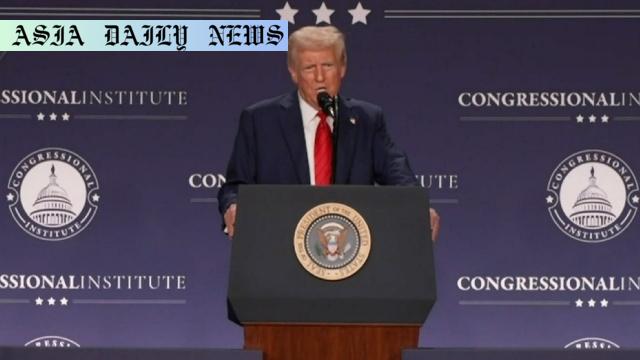Tariffs – Trump proposes semiconductors and pharmaceuticals tariffs to rejuvenate domestic production.
- Trump proposes new tariffs on semiconductors and pharmaceuticals.
- Plan aims to bring manufacturing back to the United States.
- Trump criticizes Biden’s subsidy programs as ineffective.
- Claims tariffs will incentivize domestic infrastructure growth.

Trump’s Vision for Tariffs: Bringing Back US Manufacturing
Former President Donald Trump has announced bold plans to impose tariffs on imported semiconductors and pharmaceuticals as part of a strategy to rejuvenate domestic production. Speaking during a rally in Florida, Trump underscored the necessity of revitalizing the American manufacturing sector, with a particular focus on industries that have seen significant outsourcing to countries like Taiwan.
The Case for Tariffs on Semiconductors
Semiconductors, a critical component for modern technology, have long been produced overseas, particularly in Taiwan, which accounts for the majority of global chip production. Trump argued that these industries have left the U.S. due to competitive advantages offered abroad, such as lower labor costs and fewer regulatory hurdles. In his speech, Trump vowed to impose tariffs on semiconductor imports, creating a financial incentive for chip manufacturers to reestablish production facilities in the U.S.
Critics, however, might point out that such a move could increase costs for consumers and businesses relying on affordable electronic products. Nonetheless, Trump remained unwavering in his belief that long-term benefits outweigh the short-term challenges, stating, “We want them to come back.”
Tariffs on Pharmaceuticals: Reducing Dependency
In addition to semiconductors, Trump also targeted the pharmaceutical sector. Pharmaceuticals, like semiconductors, are often imported due to the cost-effectiveness of overseas production. By imposing tariffs, Trump aims to reduce America’s dependency on foreign supply chains, especially in light of lessons learned during the COVID-19 pandemic. Supply chain interruptions then highlighted the vulnerabilities of relying too heavily on international sources for essential medications.
Criticism of Biden’s Subsidy Programs
Trump expressed dissatisfaction with the subsidy programs introduced under President Joe Biden’s administration, labeling them as “ridiculous.” Biden’s subsidies were designed as financial incentives to encourage U.S.-based manufacturing but, according to Trump, have failed to produce the desired results rapidly. Trump’s proposed tariffs are positioned as a more immediate and forceful approach to achieving similar objectives.
The Broader Narrative of Economic Revival
Framing his announcement within the broader narrative of American prosperity, Trump described this plan as part of a new “Golden Age of America.” Reflecting on his previous tenure, he highlighted accomplishments such as numerous executive actions and stricter enforcement of immigration policies, linking these to his broader vision of economic renewal and national stability.
While critics express concerns over potential retaliation from trade partners and increased consumer prices, proponents of the plan argue that investing in domestic infrastructure could lead to long-term economic benefits, including job creation and enhanced technological innovation.
The Path Forward
Trump’s tariff proposal underscores a significant shift toward economic nationalism, focusing on bolstering domestic industries through governmental interventions. While his measures promise substantial change, they are not without risks, such as potential trade wars and backlash from allied nations. The coming months will likely witness intense debate over the viability and implications of such a strategy for the future of the American economy.



Commentary
The Rationale Behind Trump’s Bold Tariff Strategy
Donald Trump’s plan to impose tariffs on semiconductors and pharmaceuticals reflects his commitment to prioritizing American-made production. While the idea of applying tariffs may initially seem aggressive, it is grounded in the reality of an increasingly globalized economy in which the U.S. has ceded dominance in critical industries to foreign nations. By implementing these tariffs, Trump seeks to reverse these trends and establish a more self-reliant national economy.
Potential Challenges and Risks
Although Trump’s strategy has its merits, potential risks cannot be ignored. Tariffs could lead to increased production costs for businesses reliant on affordable semiconductors, which might then be passed on to American consumers. Additionally, these measures could provoke retaliatory tariffs from trade partners or disrupt existing supply chains, creating challenges for both businesses and investors. Balancing the pursuit of domestic growth with minimal economic disruption will be an inherent challenge.
Long-Term Vision and Its Impacts
One of the strongest arguments in favor of Trump’s approach is its focus on long-term benefits. Revitalizing domestic industries could create jobs, spur innovation, and decrease reliance on external supply chains during global crises, as witnessed during the pandemic. While the journey may be complex, such efforts could provide a stable foundation for American economic growth in years to come.
In summary, while Trump’s tariff proposal is not without controversy, its underlying objective of boosting American manufacturing capabilities holds significant promise. It remains to be seen how these measures will unfold and whether they will achieve the ambitious goals they set to accomplish.